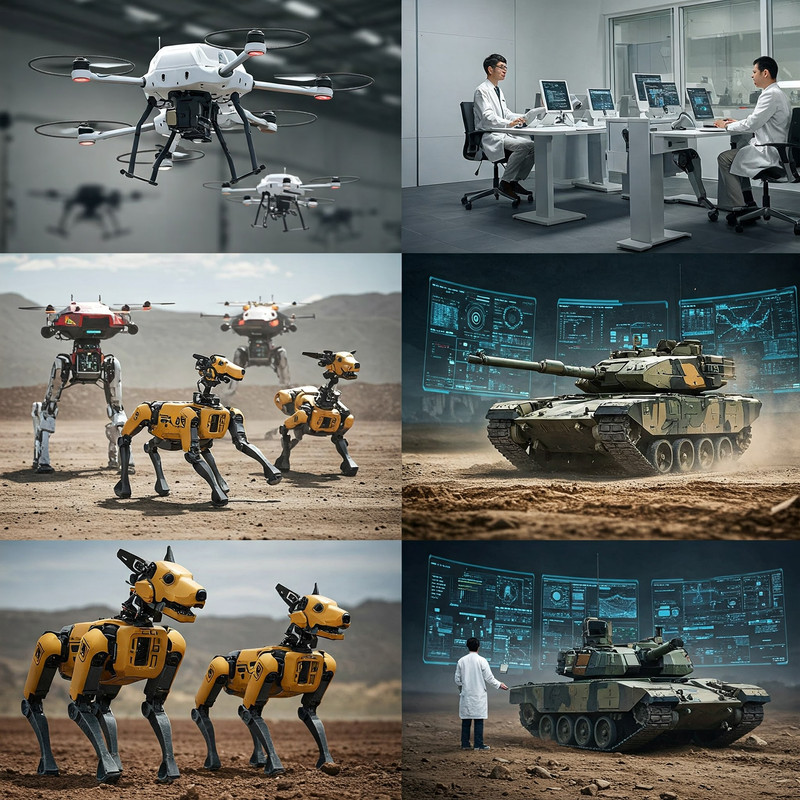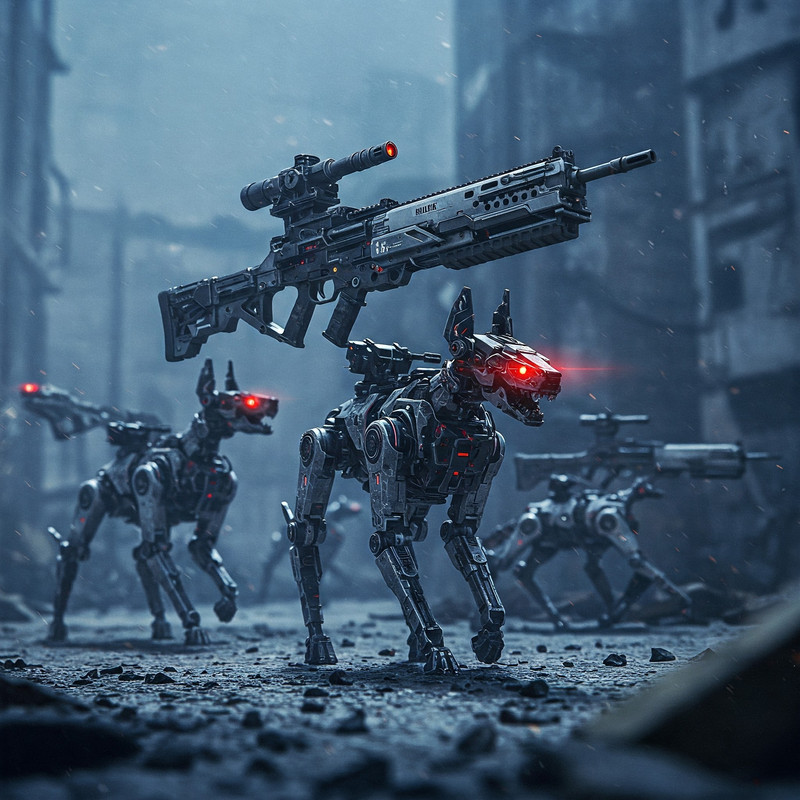Human soldiers vs AI soldiers
AI in Warfare: How Artificial Intelligence is Revolutionizing Modern Battlefields
Published on: May 21, 2025
Labels: AI in Warfare, Future Technology, Military AI, Autonomous Drones, Robotics, Cyber Warfare, AI Ethics

Artificial Intelligence is rapidly advancing the capabilities of robotic infantry on the modern battlefield.
Introduction: The Dawn of Algorithmic Warfare
Artificial Intelligence (AI) is fundamentally reshaping every sector of human endeavor, and the military domain is no exception. From precision-guided autonomous drones to self-learning combat robots and advanced decision-support systems, AI is introducing capabilities that were once confined to the pages of science fiction. The integration of AI promises to alter the speed, precision, and strategic depth of military operations, signaling a new era of warfare where algorithms play an increasingly critical role.

Advanced AI systems are enabling seamless coordination between autonomous robots and drones in complex combat scenarios.
Key Applications of AI in Modern Warfare
The applications of AI in military contexts are diverse and expanding rapidly, covering various operational layers:
- Lethal Autonomous Weapons Systems (LAWS): Often dubbed "killer robots," these systems are capable of identifying, tracking, and engaging targets without direct human intervention. This includes autonomous drones for surveillance and strike, and robotic ground vehicles for combat operations.
- Robotic Soldiers and Support Units: Beyond direct combat, AI-powered robotics are being developed for tasks like reconnaissance, logistics (e.g., transporting supplies in dangerous zones), demining, and even medical evacuation, thereby reducing direct human exposure to harm.
- Advanced Decision Support Systems: AI algorithms analyze vast amounts of real-time battlefield data (from sensors, intelligence feeds, surveillance) to provide commanders with rapid, data-driven insights. This includes predictive analytics for enemy movements, optimal troop deployment strategies, and risk assessment, enhancing strategic decision-making.
- Cyber Warfare and Defense: AI plays a crucial role in both offensive and defensive cyber operations. It can be used to automatically detect and neutralize sophisticated cyber threats, identify vulnerabilities in enemy networks, or launch targeted cyberattacks with greater speed and precision than human operators.
- Intelligence, Surveillance, and Reconnaissance (ISR): AI processes immense volumes of satellite imagery, drone footage, and sensor data to quickly identify patterns, detect objects of interest, and monitor activity in real-time, greatly enhancing intelligence gathering capabilities.
- Logistics and Maintenance: AI optimizes supply chains, predicts equipment failures before they occur (predictive maintenance), and manages inventories for military forces, ensuring operational readiness and efficiency.

Autonomous robotic units, like these advanced robotic dogs, represent a significant leap in ground combat and support.
Advantages of AI on the Battlefield
The integration of AI offers several compelling advantages that appeal to modern militaries:
- Increased Efficiency and Faster Reaction Time: AI systems can process information and execute commands at speeds far beyond human capability, leading to rapid responses in dynamic combat environments.
- Reduced Human Casualties: By deploying autonomous systems for dangerous missions (e.g., clearing minefields, urban combat), AI can significantly reduce the risk to human soldiers' lives.
- Greater Intelligence Gathering Capability: AI's ability to analyze vast datasets from multiple sources provides a more comprehensive and real-time understanding of the battlefield.
- More Strategic Warfare Decisions: Predictive analytics allow commanders to anticipate enemy actions, optimize resource allocation, and develop more effective long-term strategies.
- Unwavering Endurance: Unlike human soldiers, AI systems do not suffer from fatigue, fear, or stress, allowing for continuous operation in harsh conditions.
Challenges and Ethical Dilemmas of AI in Warfare
Despite the advantages, the rise of AI in warfare introduces profound challenges and critical ethical dilemmas that necessitate careful consideration and international discourse:
- Ethical Concerns and Accountability: The most contentious issue revolves around "Lethal Autonomous Weapons Systems" (LAWS) and the delegation of lethal decision-making to machines. Who is accountable if an AI system makes a mistake or commits an atrocity? The lack of human morality, empathy, or understanding of proportionality in a machine's decision-making process is a major concern.
- Hacking Risks and Cyber Vulnerabilities: Autonomous AI systems present tempting targets for enemy forces. Hacking and taking control of such systems could turn them against their creators or lead to unpredictable and dangerous outcomes.
- Loss of Human Oversight and Control: An overreliance on fully autonomous systems could lead to a dangerous erosion of human oversight, making it difficult to intervene or understand the chain of events leading to unintended consequences or systemic failures.
- Escalation and Arms Race: The development and deployment of AI in warfare could trigger a new, potentially uncontrollable, global arms race, increasing geopolitical instability.
- Unpredictability and 'Black Box' Problem: Some advanced AI models operate as "black boxes," making decisions through complex neural networks that are difficult for humans to fully understand or audit, posing challenges for trust and accountability.
Comparison Table: Human vs. AI in Military Operations
| Aspect | Human Soldiers | AI Systems |
|---|---|---|
| Decision Making | Slower, influenced by emotion, ethics, and fatigue; adaptable to novel situations. | Extremely fast, data-driven, consistent; limited by programming and unforeseen circumstances. |
| Risk Factor | High (Human life at stake, physical and psychological trauma). | Low (Machine loss only; no physical or psychological harm to operators from direct engagement). |
| Flexibility | Highly creative, adaptable under pressure, can understand nuanced situations. | Limited to programming and trained data; struggles with truly novel, out-of-sample situations. |
| Endurance | Physically and psychologically limited; requires rest, sustenance, and recovery. | Can operate 24/7 in harsh environments (within power limits); no psychological impact. |
| Cost | Extensive training, ongoing support, and potential long-term care for personnel are expensive. | High development and acquisition cost, but lower per-mission operational costs (no personnel expenses). |
Explore More Science by Rao:
- The Moon as Earth’s Backup: Why Lunar Colonization Is Back in the Spotlight
- Terraforming Mars: Can We Turn the Red Planet Green?
- AI Weather Control: Can We Stop Hurricanes and Droughts?
- The Future of Nuclear Fusion: Unlimited Clean Energy?
- Powering Earth from the Stars: Space-Based Solar Energy
- AI in Space Exploration: How Artificial Intelligence is Powering Interstellar Missions
Follow and Connect with Science by Rao:
Stay updated by clicking the follow button on the sidebar!
Privacy Policy | Disclaimer | About the Author
Comments
Post a Comment